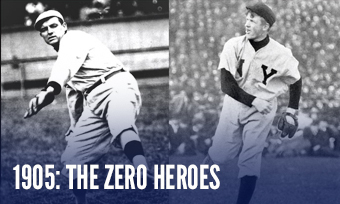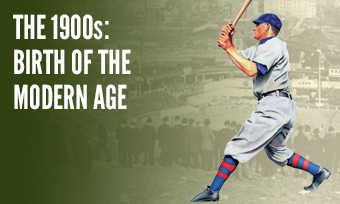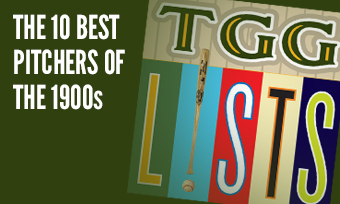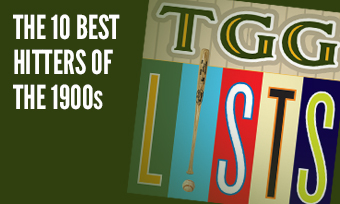The Yearly Reader
Leaders and Honors, 1905
Our list of baseball’s top 10 hitters and pitchers in both the American League and National League for the 1905 baseball season, as well as the awards and honors given to the game’s top achievers of the year.
The National League’s Top 10 Hitters, 1905
Bold type in brick red indicates league leader.
1. Honus Wagner, Pittsburgh
Key Numbers: .363 average, 114 runs, 199 hits, 6 home runs, 101 RBIs, 57 stolen bases.
The Flying Dutchman continued to soar as the NL’s best despite not leading the league in any one single offensive category for the only time in the decade.
2. Cy Seymour, Cincinnati
Key Numbers: .377 average, 219 hits, 40 doubles, 21 triples, 8 home runs, 121 RBIs.
As major league pitchers dominated more than ever, Cy Seymour managed to collect more total bases (325) than any other National Leaguer during the Deadball Era.
3. Mike Donlin, New York
Key Numbers: .356 average, 124 runs, 216 hits, 16 triples, 7 home runs, 80 RBIs.
Donlin got his mind off of both theater and trouble long enough to get in a full season—and a spectacular one at that.
4. Sherry Magee, Philadelphia
Key Numbers: .299 average, 100 runs, 17 triples, 5 home runs, 98 RBIs, 48 stolen bases.
The sophomore campaign of the 20-year-old Magee, literally plucked off a sandlot in Pennsylvania, made many solid veteran hitters look ordinary.
5. Frank Chance, Chicago
Key Numbers: 118 games, .316 average, 92 runs, 70 RBIs, 78 walks, 17 hit-by-pitches, 38 stolen bases, .450 on-base percentage.
Taking over the reins as Cubs player-manager at midseason had little effect on Chance’s performance at the plate, setting a personal best in on-base percentage.
6. Sam Mertes, New York
Key Numbers: .279 average, 27 doubles, 17 triples, 5 home runs, 108 RBIs, 52 stolen bases.
In his last solid year before being distracted by earthquake-related events back in his native San Francisco, Mertes notched career highs in triples and RBIs.
7. John Titus, Philadelphia
Key Numbers: .308 average, 99 runs, 36 doubles, 14 triples, 89 RBIs, 69 walks.
Perhaps Titus’ handlebar mustache—he was reportedly the last to wear one in the majors until the A’s of the 1970s revived it—had grown passé, but his playing abilities surely had not.
8. Dan McGann, New York
Key Numbers: .299 average, 88 runs, 14 triples, 5 home runs, 75 RBIs, 19 hit-by-pitches.
A disciple of Giants’ manager John McGraw’s combative tactics, McGann led the charge with strong numbers and a NL-leading five ejections.
9. Roy Thomas, Philadelphia
Key Numbers: .317 average, 118 runs, 93 walks.
Thomas didn’t lead the NL in walks for the first time in five years, but with a stellar batting average remained just as potent in his ability to reach base.
10. Fred Clarke, Pittsburgh
Key Numbers: .299 average, 95 runs, 15 triples.
The Pirates’ outfielder-manager returned to full-time everyday play after logging only 72 games in 1904.
The American League’s Top 10 Hitters, 1905
1. Elmer Flick, Cleveland
Key Numbers: .308 average, 29 doubles, 18 triples, 35 stolen bases.
An early season injury to Cleveland superstar Nap Lajoie made Flick the lead guy in the Naps’ lineup; his batting average was the lowest for a league leader until 1968.
2. Harry Davis, Philadelphia
Key Numbers: .285 average, 93 runs, 47 doubles, 8 home runs, 83 RBIs, 36 stolen bases.
Davis continued his reign as the American League home run king, for all it was worth in 1905.
3. Sam Crawford, Detroit
Key Numbers: .297 average, 38 doubles, 6 home runs, 75 RBIs.
In virtually his last season B.C. (Before Cobb), Crawford did well to pull his own weight for the Tigers.
4. Topsy Hartsel, Philadelphia
Key Numbers: .275 average, 88 runs, 8 triples, 121 walks, 37 stolen bases, .409 on-base percentage.
A career-high total in walks catapulted Hartsel’s batting average to an AL-best on-base percentage.
5. Jiggs Donahue, Chicago
Key Numbers: .287 average, 76 RBIs, 32 stolen bases.
Given his name because he used to dance at his family store as a kid, Jiggs certainly got White Sox fans on their feet with his initial everyday effort.
6. Danny Murphy, Philadelphia
Key Numbers: .277 average, 34 doubles, 6 home runs, 71 RBIs, 23 stolen bases.
Strong numbers given the times, Murphy set career highs in doubles and steals.
7. George Stone, St. Louis
Key Numbers: .296 average, 187 hits, 13 triples, 7 home runs.
The Browns got Stone (zero career hits) from Boston for aging star Jesse Burkett (2,703); of course, the Browns got the better of the deal.
8. Jake Stahl, Washington
Key Numbers: .250 average, 12 triples, 5 home runs, 66 RBIs, 17 hit-by-pitches, 41 stolen bases.
Unrelated to the ill-fated Chick Stahl in Boston, Jake forged enough productivity from a .250 batting average to make this cut.
9. Harry Bay, Cleveland
Key Numbers: .301 average, 90 runs, 10 triples, 36 stolen bases.
In what would be his last year as an everyday player, Bay was one of only three AL players to hit over .300.
10. Socks Seybold, Philadelphia
Key Numbers: .274 average, 37 doubles, 6 home runs, 59 RBIs.
Despite a drop in batting average (down to a still-respectable-for-the-Deadball-Era .274), Socks still managed to possess enough sock to keep A’s fans content.
The National League’s Top 10 Pitchers, 1905
1. Christy Mathewson, New York
Key Numbers: 1.28 ERA, 31 wins, 9 losses, .775 win percentage, 338.2 innings.
With his third straight 30-win season and first sub-2.00 ERA campaign in the books—and with teammate Joe McGinnity having peaked—Mathewson firmly established himself in the position most everyone had predicted of him: The game’s best pitcher.
2. Ed Reulbach, Chicago
Key Numbers: 1.42 ERA, 18 wins, 14 losses, 291.2 innings.
By finishing second in NL ERA and firing two wins taking 18-plus innings, some wondered aloud if the 22-year-old rookie was first in line to dethrone Mathewson.
3. Deacon Phillippe, Pittsburgh
Key Numbers: 2.19 ERA, 20 wins, 13 losses, 279 innings.
After an off-year—perhaps recovering from his overuse at the 1903 World Series—Phillippe got back on track and secured the final 20-win season of his career.
4. Irv Young, Boston
Key Numbers: 2.90 ERA, 20 wins, 21 losses, 7 shutouts, 42 starts, 378 innings.
Playing for a pathetic Boston team (103 losses) with no offense, the 28-year-old rookie—no relation to Cy Young, across town—managed to be the only one of the Beanaters’ four 20-game losers to also win 20.
5. Togie Pittinger, Philadelphia
Key Numbers: 3.09 ERA, 23 wins, 14 losses, 46 appearances, 337.1 innings.
Pittinger, who could relate to Young after tolerating back-to-back 20-loss campaigns in Boston from 1903-04, turned his fortunes around with a much better team in Philadelphia.
6. Bob Wicker, Chicago
Key Numbers: 2.02 ERA, 13 wins, 6 losses.
A late arrival after a bout with bronchitis—and then, two weeks quarantined in his apartment building after it was hit by smallpox—Wicker quietly put together a stifling effort.
7. Three Finger Brown, Chicago
Key Numbers: 2.17 ERA, 18 wins, 12 losses, 249 innings.
An unspectacular and yet still impressive campaign for Brown, on the eve of his far more spectacular run of success.
8. Joe McGinnity, New York
Key Numbers: 2.87 ERA, 21 wins, 15 losses, 46 appearances, 320.1 innings.
Ironman Joe cooled off from his über-productive ace work—his 320.1 innings were the fewest he had thrown in seven seasons to date—but he remained a worthy companion to Mathewson.
9. Tully Sparks, Philadelphia
Key Numbers: 2.18 ERA, 14 wins, 11 losses.
Sparks bounced back from a 7-16 record in 1904; it didn’t hurt that the Phillies gave him an additional two runs’ worth of offensive support.
10. Buttons Briggs, Chicago
Key Numbers: 2.14 ERA, 8 wins, 8 losses, 168 innings.
Despite an innocuous 8-8 record, Briggs enjoyed a far better (albeit brief) return to the Cubs after a rough first spell in Chicago during the late 1890s.
The American League’s Top 10 Pitchers, 1905
1. Rube Waddell, Philadelphia
Key Numbers: 1.48 ERA, 27 wins, 10 losses, .730 win percentage, 46 appearances, 287 strikeouts, 328.2 innings.
The Wild One enjoyed the peak of his career—but he got too wild with Andy Coakley on a train platform just before the World Series and missed what would have been the only postseason experience of his career.
2. Cy Young, Boston
Key Numbers: 1.82 ERA, 18 wins, 19 losses, 320.2 innings, 30 walks.
Young was the victim of a growing baseball epidemic: A losing record despite a sub-2.00 ERA.
3. Nick Altrock, Chicago
Key Numbers: 1.88 ERA, 23 wins, 12 losses, 315.2 innings.
Later to be known as part of a famed entertainment sideshow at ballparks, Altrock was hardly clowning around for the moment in Chicago.
4. Frank Owen, Chicago
Key Numbers: 2.10 ERA, 21 wins, 13 losses, 334 innings.
Owen followed up his breakout season with similar numbers for the White Sox.
5. Eddie Plank, Philadelphia
Key Numbers: 2.26 ERA, 24 wins, 12 losses, 41 starts, 346.2 innings.
While Waddell was stealing the headlines—good and bad—teammate Plank quietly and contentedly went about his usual sterling business.
6. Doc White, Chicago
Key Numbers: 1.76 ERA, 17 wins, 13 losses.
Like teammate Frank Owen above, White hummed along with an effort virtually cloned from his 1904 numbers.
7. Addie Joss, Cleveland
Key Numbers: 2.01 ERA, 20 wins, 12 losses, 286 innings.
The calm and collected right-hander settled into his role as Cleveland ace by recording his first 20-win season.
8. Ed Killian, Detroit
Key Numbers: 2.27 ERA, 23 wins, 14 losses, 8 shutouts, 313.1 innings.
From flop to flip; after losing 20 in his first full season, Killian turned things around and notched 20-plus wins.
9. Frank Smith, Chicago
Key Numbers: 2.13 ERA, 19 wins, 291.2 innings.
After a superlative rookie showing, Smith worked himself into more of a workhorse role and ensured that all four White Sox starters would make this list.
10. Harry Howell, St. Louis
Key Numbers: 1.98 ERA, 15 wins, 22 losses, 35 complete games, 323 innings.
The quality-driven Howell continued to get no breaks from a lousy (54-99) Browns side, suffering the most losses ever by an AL pitcher with a sub-2.00 ERA.









